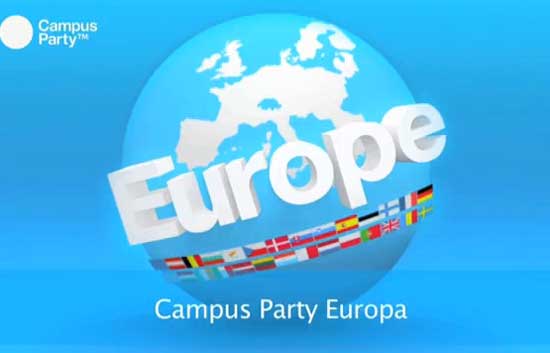11/10/2011 - Events, Projects
Campus Party Granada, 12-16 of October: School of Robotics carries on two sparkling ideas.

 Reading time: 2 minutes
Reading time: 2 minutesCampus Party Millennium takes place in Granada and is a unique showcase for cutting edge technologies on the Internet. The School of Robotics has been invited to present two brilliant ideas.
TECHNOLOGY FOR PEACE
This edition's mission is: Technology for peace.
To mark the millennium of the Kingdom of Granada, October 12th-26th takes place a special Campus Party Millennium edition in the beautiful Andalusian city with keynote speakers, experts, and 600 invited participants from 22 countries in the Mediterranean Basin. Campus Party Millennium is a place for sharing expertise, fostering collaboration and identifying trends and innovative projects that offer the opportunity to interact in a multidisciplinary and culturally diverse environment. It’s a unique international experience that puts value to the emerging talent and innovation in the Network of Mediterranean countries, East-West relations and the role of ICT in sustainable economic development, international cooperation, respect for human rights and overcoming cultural barriers and conflicts of coexistence.
School of Robotics is there. Davide Canepa and Alessandro Divano have brought to Granada two brilliant ideas.
Davide Canepa’s project
At Campus Party 2011 in Granada I would like to present a project - which I have developed applying Lab VIEW, the popular data-acquisition application - to image recognition to command mobile robots. I have employed LabVIEW (LV from now on) to have a webcam recognising images (letters, numbers) and, always via LV, have these images translated in commands to the robot: to move, to turn, etc. The robot gets these commands via Bluetooth. Children can even draw the images, which LV translates in commands to the robot, because I have “trained” LV to recognise also low-precise patterns. These way, also very little kids can start commanding a robot via images. This application is a very smart and playful educational tool for children. LV can acquire images of any shape and colour: more is the image complex, more LV is working to translate it in machine language. The robot that I have used is Lego NXT, set up in Explorer mode, with 2 engines for mobility, and a third to move the ultra red sensor and a small camera. The ultra red sensor and the camera send their data to a pc (feedback). It is by this sensor that the robot can autonomously correct possible command errors disabling the user-command when wrong or dangerous, and resetting itself in safety position. Users can also command the robot from pc: the mobile robot, which can move also on rugged ter¬rains thank to its caterpillar tracks, can send to pc the webcam acquired images, giving to the user the picture of the environment. We have already tested this applica tion with kids, with great enthusiasm and success.
Alessandro’s project
Robodesign is a project which is based on a year-long researches jointly developed by the School of Robotics and the Department of Architecture and Industrial Design of the University of Genoa, Italy. It aims at finding and selecting the best robots’ design, which is carefully studied fitting fundamental human paradigms and needs, and be accurately mold for the set robots’ functions. We have worked on the design for the following classes of robots:
1. Underwater robotics for entertainment and museum applications;
2. Robots and interactive devices for users with special needs (autism, elders etc);
3. Humanoids.
For each robot’s design we considered the human-centered point of view and the specifics of a techno¬logical application. In so doing we applied roboethical recommendations and rules also imagining new and more human-cooperative robotics applications.
At Campus Party Millenium we would like to present our last robotics design, that is:
• In the class of humanoid robots, we have introduced the concept of a “garbage robot” to work with people on an ecological life style;
• For underwater robotics, we have developed several robot’s models for aquarium and museum.
• For users’ special needs, we focused on robotics for autistic children, with the design of a special wrist-watch, which can detect children’s mood and can com¬municate it to tutors and educators.
• Another project is focused on the physical wellness: the design of a robotics

